| |
 |
 |
Volume 8.2
April-June 2011
For Private Circulation Only
|
| |
In this Issue
Outreach
Academy
New
Announcements
We are moving our Northeast regional office to Gangtok, Sikkim from Darjeeling. Dr. Sarala Khaling is our new Regional Director for the Northeast. Outgoing Regional Director, Suman Rai, will continue to head ATREE’s community-based conservation centre at Darjeeling and our NE small grants programme.

|
Manas is out of danger
The World Heritage Centre at Paris finally decided to remove the ‘In Danger’ tag and reinstate Manas Wildlife Sanctuary/National Park in Assam to its original World Heritage Site (WHS) status. This decision was made during its annual meeting earlier this June. This followed from five UNESCO-IUCN monitoring mission reports over 19 years, when Manas National Park was declared a WHS ‘in Danger’ by UNESCO.

Manas was inscribed as a WHS way back in 1985 based on criteria of spectacular natural landscape, outstanding example of ecological and biological processes, and representing unique biological diversity for in situ conservation. However, these attributes were severely compromised due to ethnic insurgency through the 1990s, resulting in damages to park infrastructure and depletion of forest habitat and wildlife populations. Consequently, Manas came to be listed as a ‘World Heritage Site in Danger’ in 1992. Political resolution of the ethnic uprising in 2003 has resulted in gradual improvement of the situation.
This success is the result of combined efforts of the government, scientific fraternity, conservation NGOs and local communities. ATREE, in its own way, has been a strategic contributor to this entire process. ATREE’s scientific research for monitoring recovery of wildlife population and habitat in Manas, going back nearly five years, helped to initiate baseline information and demonstrate improvement of biodiversity in the site. ATREE’s administration of the World Heritage Biodiversity Project in Manas over the last three years has been oriented towards supporting critical needs of the park management and local communities and improving the site’s profile. The team also helped park authorities prepare reports and documentation that were submitted to the World Heritage Centre. ATREE interacted closely with the monitoring mission which visited Manas in January 2011, based on whose report the current decision on Manas was expedited. ATREE’s association with Manas and this positive development on the WHS front is very encouraging.
Official news release can be accessed at http://www.iucn.org/?uNewsID=7708.
Niraj Kakati, Guwahati
|
Outreach
Participatory mapping of natural resources
Vembanad CERC has initiated participatory mapping of natural resources in the Vembanad Lake. This project aims to record past and current trends of natural resources, that is fish, clam, mangrove patches, shells, otters, trees, birding areas and so on in the southern sector of the Vembanad Lake. The project will involve primary stakeholders such as fishermen, clam collectors, local people and tourism operators among others, who make their livelihood from the lake. Ultimately, this is expected to lead to the creation of a resource map which will be available in the public domain for reference. It has the funding support of the Department of Environment and Climate Change, Government of Kerala.
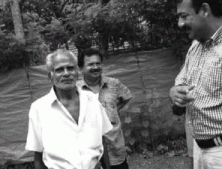
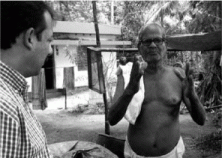
|
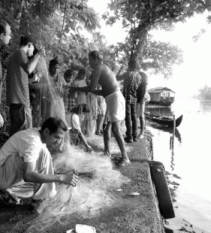
The lake, a Ramsar site, is renowned for its live clam resources and sub-fossil deposits, as a habitat for the vulnerable spot-billed pelican, a large bird population, and high species diversity of fin fish and shellfish. Human intervention has drastically reduced primary productivity and fishery resources and altered the landscape of this large humid tropical wetland, and the terrestrial and aquatic fauna and flora. There is poor documentation and monitoring of natural resources, creating a blind spot in the structuring of appropriate management plans for the lake.
The resource mapping project was initiated in Muhamma panchayat in June. Vechur, Aymanam, Kumarakom, Kainakary, Punnappra, Mannancherry, Thanneermukkom, Aryad and Alappuzha Municipality panchayats are likely to follow its lead. Maps from the different areas will be combined, converted to GIS maps and made into tools for future planning exercises. This exercise is being carried out by the Eco-Informatics Lab team in ATREE. The participatory appraisals techniques applied in Muhamma panchayat includes participatory mapping by the primary stakeholders, focus group discussions, transect walks along the banks of the river and interaction with residents, interviews with senior citizens for older narratives, discussions and mapping exercise with clam societies, Lake Protection Forums and the Gram Panchayat
|
committee. The exercise is helping to clarify current status, past and present trends, cause-effect relationships and possible interventions. Besides, the team hopes that it will help instill a sense of ownership of the lake and its condition among participants.
Along with mapping of resources, zones used for subsistence activities such as fishing, sand mining, clam collection, gathering of fodder, house boats, resorts, tourism activities in the lake, weed-covered areas and any other significant use of the lake will also be mapped. The project period is 14 months, starting May 2011.
Dr Latha Bhaskar, Vembanad CERC
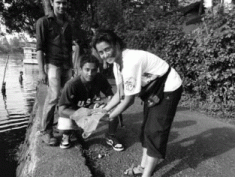
The fourth Vembanad fish count
The annual Vemabanad fish count by the Vembanad CERC team has revealed an alarming fall in aquatic life in the ecologically fragile lake. The fourth edition of the count organized on 25-26th May this year recorded only 45 species of fin fish and nine species of crustaceans. A major concern is the loss of marine migrants owing to the irregular operation of the salt water barrier—the Thanneermukkom barrage. Plastic waste has been identified as the major inorganic pollutant, adversely affecting bottom
|
|
feeders like gobids and fishes that attach their eggs to lake-bottom soil. Dissolved oxygen, vital for fishes to survive, was found to be as low as 2-3ppm, whereas the ideal is 4-5ppm. Another key observation that may account for the rise in mosquito borne disease in the region is the decline in larvivorous fishes. These, along with frogs, keep mosquito populations in check.
The survey was a joint effort of researchers, academicians, fisheries’ students, media, naturalists and public. It highlighted the deteriorating situation of the lake for yet another year. Dr. Madhusoodhana Kurup, Honorable Vice Chancellor of Kerala University for Fisheries and Ocean Studies, who has conducted several research studies in Vembanad lake in 1985, including water balance study, suggested using this research, and ATREE’s current work to make a comparison report of the then and now status. CERC has taken this on and will suggest remedial interventions to concerned government departments based on the analysis.
CERC partners in the fish survey were Kerala University for Fisheries and Ocean Sciences (KUFOS), Kerala State Biodiversity Board, Regional Agricultural Research Station (RARS) Kumarakom, St Albert’s College, Ernakulam, Vembanad Nature Club, Lake Protection Forums, and Department of Environment Sciences, Mahatma Gandhi University. Kerala State Council for Science Technology and the Environment is expected to provide funding support to this event, and the proposal is still under their consideration.
Dr Latha Bhaskar, Vembanad CERC
|
SMS as a tool in tracking biodiversity
The Agasthyamalai team is in the process of setting up a community-based biodiversity monitoring programme in Tirunelveli and Tuticorin districts of Tamil Nadu. One of the methods used for monitoring is reporting observations to a specified phone number through an SMS.
This is part outcome of a series of workshops planned as a follow up to the bilingual nature guide ‘Treasures on Tigers Tracks’ released in 2009 by the Agasthya team. The purpose of the workshops is to demonstrate how the guide can be used to identify biodiversity. It is expected that teachers will learn to identify common plants, birds, butterflies and mammals and they are expected to pass on these skills to their students or interested people in their locality. The first of these workshops –‘Nature Tracking – Biodiversity Monitoring workshop’ was held on June 11 and 12 at the Agasthyamalai Community-based Conservation Centre (ACCC). The data thus collected will be collated and made available through the Internet.
|
The workshop was flagged off with an introduction to biodiversity in KMTR and its buffer zone. The team gave a short presentation on monitoring, explaining how it could be used for biodiversity assessment, the need for monitoring, and indicators used. Volunteers were taken for a bird-watching trip to the nearby wetlands in Vairavikulam and Pappankulam. The participants got hands-on experience in identifying the birds by their characteristic features and naming them. They then used the dedicated mobile to send an SMS with the relevant species code and details of the sightings. On returning to the field station, the Agasthya team showed how the data sent by participants via SMS was compiled, and demonstrated the possibility of showing this on a real time map.On the following day, the group visited a dry forest where Dr. Ganesan demonstrated how leaf structure could be used as a key to identify the plant species. This was met with great enthusiasm as participants began to discern differences in trees which were earlier all green to them.
|
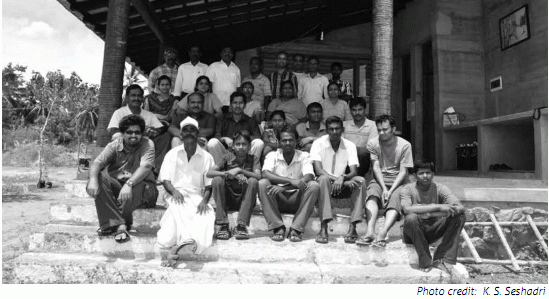
|
|
Mr. Venkatesh, Deputy Director of KMTR and Mr. Gajendra Babu, District Environment Coordinator for Schools also participated in the event. Dr. Soubadra Devy, R Ganesan, Dr. T. Ganesh, M. Mathivanan, Jahnavi Pai, Sharadha Ramadoss, A. Saravanan and Seshadri were part of the team from ATREE. As this test run was successful, the team plans to replicate this exercise with many such groups.
M. Mathivanan, Agasthyamalai CCC
World Environment Day
ATREE celebrated World Environment Day on June 10th with 200 school students from 11 different schools, conservation organizations and civil society from in and around the Jakkur area in Bangalore. Inaugurating the celebrations, Dr Ravi Chellam, wildlife biologist and conservationist, and former Director, ATREE, talked about different meanings of the word ‘conservation’. He explained how conservation is not only ‘protection’ or safe guarding, but can translate to mean ‘judicious use’, which everybody could participate in by making choices that are environment friendly.
Children lent colour and energy to the day with their enthusiastic enquiry into medicinal and other plants, bird watching, water conservation, insect identification, Geographical Information Systems (GIS), India Biodiversity Portal, and conservation genetics. ATREE had organized activities related to these aspects in and around ATREE and Rachenahalli lake. The lake also became a site for
|
explaining the significance of lake ecology, water resources and birds. ATREE’s Eco-informatics Laboratory introduced students to the use of GIS. They were also introduced to web applications that could help them identify a tree or a migrant bird or to locate the distribution of a species in India.
An art competition organized as a part of the celebrations saw 100 students convey what nature, water conservation and neighborhood parks meant to them. The three best artworks in each category received prizes. Mr. Mohamed Attaulla Khan, Principal, KK English School, Varthur gave the keynote speech on environment. This year’s Khoshoo School Awards winners also shared their view on environment and conservation.
There were exhibition stalls by Mahatma Gandhi Regional Institute of Rural Energy and Development on alternative energy such as biofuel and solar energy, Sahaja Samrudha on organic food, Daily Dump on waste management, and ATREE on lantana products. Suma TS from Foundation for Revitalisation of Local Health Traditions (FRLHT) introduced students to medicinal plants grown in Bangalore. Value added products made by Soliga women Self Help Groups in BR Hills and lantana products made by Soliga artisans from MM Hills were put up for sale.
This programme has been partly funded by Axis Bank and JTT.
Siddappa Setty, Bengaluru
|
Academy
Dr. Bharath Sundaram, ATREE’s first PhD student, successfully defended his thesis, ‘Patterns and Processes of Lantana camara persistence in South Indian Tropical Dry Forests’ in June 2011, and has been provisionally awarded the PhD degree by Manipal University.
Noragric–ATREE partnership ends
ATREE and Noragric, Norwegian University of Life Sciences, Ås will end a productive academic collaboration on research and learning on 31st July 2011. The programme, Conservation of Biological Diversity and Sustainable Use of Natural Resources: Capacity Building for Interdisciplinary Research and Application aimed to address tropical biodiversity and climate change issues in forest agricultural landscapes and mountains; and impacts on livelihoods and adaptation in the context of global environmental change through an academic exchange programme integrating research and education. The partnership has supported nine fellowships, eleven small grants and one post doc fellowship since it started in 2007. It has been supported by the Royal Norwegian Embassy.
Project-end workshops were held in Gangtok, Sikkim, from 27 to 29 May 2011. The workshops consisted of presentations by PhD and post doctoral scholars, and collaborating faculty. Besides Noragric and ATREE participants, students from Sikkim University and other higher educational institutions also participated.
|
|
The presentations were divided into six technical and thematic sessions over two days, for research spread over Northeast, West coast and the Western Ghats. Themes covered were Climate change, biodiversity, agriculture and pastoral livelihoods; Avian, small mammalian and aquatic diversity – habitat structure effects and community structure impacts; Local hunting and human conflicts with large mammals; Species invasion, restoration, regeneration and livelihoods; Protected Area conservation and forest rights; and Climate change, conservation and livelihoods. The workshop was closed with a summary of presentations and discussion on relevance of research done under the project for the North Eastern region.
Dr. Mahendra P Lama, Vice Chancellor, Sikkim University and Member, National Security Advisory Board inaugurated the workshop. Dr. Bishal Sitaula project head and Dr. Siddhartha Krishnan, ATREE project coordinator, flagged off presentations. A valedictory panel was organized to discuss people, biodiversity and global change with a focus on challenges in the Northeast. Panel members included Dr J P Tamang, Professor of Microbiology, Sikkim Government College, and Ms Usha Lachungpa, Senior Research Officer, Forest, Environment and Wildlife Management Department, Government of Sikkim.
Dr Siddhartha Krishnan, Bengaluru
|
Vacation Training Programme 2011
ATREE conducted its annual bio-resource certificate course for school students from 26 April to 14 May this year. Sixteen students from different schools attended. The course was advertised in local dailies, online groups and in the web, and posters were mailed to schools before the vacation started.
This year’s lecture series were on topics related to mammals, reptiles, insects, amphibians, butterflies, molluscs, diatoms, urban wildlife, wildlife rehabilitation, urban ecology, restoration ecology, climate change, biodiversity loss, forest canopies, mass extinction, genetics, ecosystem services and others. Subject experts were invited as resource persons. Previous years’ students were invited to share their experiences with the current batch.
Students were initiated into journal-writing in which they recorded a daily account of the course. They were assigned group projects that they presented at the end of the course. The subjects this year were: Effectiveness of wildlife TV channels, Attitude towards parks/ urban green spaces, Use of plastics, and Attitude towards lakes.
Participants interviewed people, collected the data, analyzed and presented it on the final day. The objective of this exercise was to get them to understand the complex issues involved in bio-resource management. The exercise also helped develop team spirit.
|
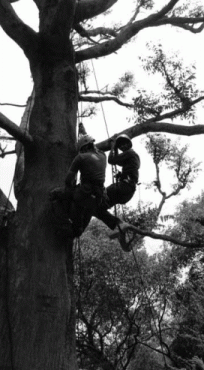
Tree climbing to better appreciate canopies, sketching birds and plants to sharpen observation skills, trapping insects, collecting and identifying diatoms: these field activities broke the monotony of the class room and were well received.
|
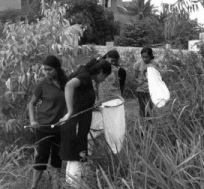
Field trips helped participants understand application of concepts learnt in class. Students visited Biligiri Rangaswamy Wildlife Sanctuary, Ramanagara vulture nesting area, Ranganathittu bird sanctuary, Butterfly
Park in Bannerghatta National Park, waste management unit of SAAHAS. Visits to Natural Remedies and Central Institute for Medicinal and Aromatic Plants exposed students to the research these institutes are concerned with. They also visited Anuganalu village in Hassan District where Biodiversity Conservation Research Trust has done restoration work and has set up a medicinal plants garden. Students learnt about the importance of the natural world in a human dominated landscape. They also learnt about green architecture.
Deserving students were awarded prizes on the last day during the valedictory function. Well known bird expert and entomologist Dr. Subramanya of GKVK presided over the valedictory function. Parents too were invited.
Students made presentations of the projects assigned to them. Dr. T. Ganesh, Dr. Aravind N. A. and Dr. Subramanya judged the projects. This was followed by certificate and prize distribution.
Abhisheka K., Bengaluru
New
Publications
Lele, S. and T. Jayaraman. 2011. Equity in the context of sustainable development, Note for UN-GSP, Ministry of Environment & Forests, Government of India, New Delhi.
Lele, S. and A. Kurien. 2011. Interdisciplinary analysis of the environment: Insights from tropical forest research. Environmental Conservation, 38(2): 211-233.
|
Shresth, Swati. 2011. Environmental History, As if Nature Existed. John R. McNeill,Jose Augusto Padua and Mahesh Rangarajan (ed). Oxford University Press, Delhi, 2010, Seminar, February 2011.
Lele, S. and T. Jayaraman. 2011. Equity in the context of sustainable development. Note for UN-GSP, Ministry of Environment & Forests, Government of India, New Delhi.
Reidsma, Pytrik and König, Hannes and Feng, Shuyi and Bezlepkina, Irina and Nesheim, Ingrid and Bonin, Muriel and Sghaier, Mongi and Purushothaman, Seema and Sieber, Stefan and van Ittersum, Martin K and Brouwer, Floor. 2011. Methods and tools for integrated assessment of land use policies on sustainable development in developing countries. Land Use Policy, 28 (3). pp. 604-617.
Manju V. Sharma and K. R. Shivanna. 2011. Pollinators, pollination efficiency and fruiting success in a wild nutmeg, Myristica dactyloides. Journal of Tropical Ecology, 27:405–412.
doi:10.1017/S0266467411000174
Raghavan, R. et al. Is the Deccan Mahseer, Tor khudree (Sykes, 1839) (Pisces: Cyprinidae) fishery in the Western Ghats Hotspot sustainable? A participatory approach to stock assessment. Fish. Res.(2011),
doi:10.1016/j.fishres.2011.03.008
Nagendra, H., and E. Ostrom. 2011. The challenge of forest diagnostics. Ecology and Society, 16(2): 20. URL:http://www.ecologyandsociety.org/vol16/iss2/art20/
Molleman, L, Boeve, Sil, Wolf, Jan, Oostermeijer, Gerard, Devy, Soubadra and Ganesan, R. 2011. Commercial harvesting and regeneration of epiphytic macrolichen communities in the Western Ghats, India. Environmental Conservation, 1-8,
doi:10.1017/S037689291100014.
Southworth, Jane, Nagendra, Harini and Cassidy, Lin. 2011. Forest transition pathways in Asia - studies from Nepal, India, Thailand, and Cambodia’, Journal of Land Use Science,
doi: 10.1080/1747423X.2010.520342
Kelsey, Rick G., Gladwin Joseph and Michael G. McWilliams. 2011. Ethanol synthesis by anoxic root segments from five cedar species relates to their habitat attributes but not their known differences in vulnerability to Phytophthora lateralis root disease. www.nrcresearchpress.com/cjfr.41:1202–1211.
He, Kate S. and Rocchini, Duccio and Neteler, Markus and Nagendra, Harini. 2011. Benefits of hyperspectral remote sensing for tracking plant invasions, Diversity and Distributions, 1-12.
|
Ramesha B. T., M. D. Yetish, G. Ravikanth, K.N. Ganeshaiah, J. Gazoul and R. Uma Shaanker. 2011. Stylish lengths: Mate choice in flowers. Journal of Bioscience, 36(2), 229-234
Ramesha B. T., S. Zuehlke, R.C. Vijay, V. Priti, G. Ravikanth, , K.N. Ganeshaiah, M. Spiteller and R. Uma Shaanker. 2011.Sequestration of camptothecin, an anticancer alkaloid, by chrysomelid beetles. Journal of Chemical Ecology, 37(5):533-536
Ramesha B. T., J. Gertsch, G. Ravikanth, V. Priti, K. N. Ganeshaiah, R. Uma Shaanker. 2011. Biodiversity and Chemodiversity: Future Perspectives in Bioprospecting. Current Drug Targets (Accepted)
Book review
Lele, S. Dynamic Sustainabilities: Technology, Environment, Social Justice. Journal of Integrative Environmental Sciences. 8(2): pp.140-143. June 2011
Popular articles
Poorna Balaji and Siddhartha Krishnan. ‘History Matters’. Down to Earth, May 2011. Harini Nagendra. An eye on the forests. Deccan Herald, June 2011.
Abhisheka K, Aravind NA, Ganesh T. Of the hunter and the hunted. Deccan Herald, 19 April 2011.
Abhisheka K, Aravind NA, Ganesh T. Learn to Value and Conserve. The New Indian Express, 11 April 2011.
Talks/ presentations by staff
Purushothaman, S. Land use regulations for poverty reduction – insights from forest peripheries of Western Ghats. For Western Ghats Ecology Experts Panel, CES. March 2011
Purushothaman, S. Implications of trends in access, benefits and status of common lands in Karnataka. Along with Lele, S. INSEE panel, IASC, Hyderabad, Jan 2011.
Thomas, Samuel. The politics of water development: A case study of Darjeeling’s water crisis. At workshop on Water justice issues in South Asia, held at Pune from 18 – 21 April 2011. Organized jointly by Wageningen University (WUR), Society for Promoting Participative Ecosystem Management (SOPPECOM) and the FORUM for Policy Dialogue on Water Conflicts in India.
|
|
Setty, Siddappa R., gave six talks on Environment and sustainable use of natural resources for Gram Panchayat representatives from Belgaum, Bellary, Bidar, Bijapur and Raichur districts at Mahatma Gandhi Institute of Rural Energy and
Development, Bangalore, from May to June 2011.
Setty, Siddappa R. Nature and conservation. Under environment education programme for school children at Vivekananda Girijana Kalyana Kendra, BR Hills. 18 May 2011.
Ozmond, Roshan D’Souza. Forest governance, conservation and livelihoods. Department of Humanities and Social Sciences, Indian Institute of Technology, Chennai. 7 June 2011.
Ravikanth, G. Ecological niche modelling in agriculture, health and forestry. School of Bio Sciences and Technology (SBST), VIT University, Vellore. 7 April, 2011.
Trainings
Obaiah, B. was invited by the Indian Academy of Sciences to give hands-on training of Koha Library Management System on 25-27th April 2011. He was also resource person for the workshop The Design and Operation of Future Digital Library, organized by The Bangalore Library Consortium, comprising of CSCS, the Alternative Law Forum (ALF), the Centre for Internet and Society (CIS) and the Centre for Contemporary Studies (CCS, Indian Institute of Science) libraries. 28 June 2011.
K. R. Shivanna. Participated in and conducted a training programme on Reproductive Ecology at the Institute of Biodiversity and Sustainable Development, Imphal (Manipur) - 15 - 21 June 2011.
Setty, Siddappa R., Participated in Western Ghats taskforce meeting to prepare ‘Karnataka State Forest Policy’ at Karnataka Forest Department on 21 June 2011.
ACCC and TREE Trust, Kallidaikurichi Jointly organised a tree planting programme at Sub Registrar office on 3 June 2011 to mark the world environment day, and later also at the new police station, Kallidaikurichi on 13 June 2011.
Setty, Siddappa R., Participated in the policy development meeting on growing medicinal plants under “Krishi Aranya Protsaha Yojane” Organized by The Karnataka Forest Department and the Karnataka Medicinal Plants Authority at Vikas Soudha, Bangalore on 3 May 2011.
Purushothaman, S. Training on Public policy analysis for Environmental Economics Research. Nancy Olewiler and SANDEE. AIT, Bangkok. May 2011.
|
Workshops
Purushothaman, S. Future of Rice in Wayanad. MSSRF, Kalpetta. Feb 2011.
Purushothaman, S. TEEB India, MoEF, Delhi. Feb 2011.
Events
CEPF-ATREE workshops: After three years into the CEPF Western Ghats Grants Programme, ATREE and CEPF conducted a series of workshops across the Western Ghats in April 2011 to evaluate and review the progress of the programme, the Regional Implementation Team (ATREE), and the grants. Participants were asked for feedback. Then, based on prioritizations set post group discussions, the ATREE and CEPF teams consolidated topics and prepared a targeted call for the next round of grants (http://www.atree.org/wgcall) in May 2011.
As of now, the Regional Implementation Team has received 39 proposals for small grants, and 17 letters of inquiry for the large grants. RIT is currently screening applications against call specifics and will process the proposals for reviews. After due process, the selected applications will join the 30 small grants and 20 large grants currently being implemented in the Western Ghats landscape (http://maps.atree.org/cepf_sites.php).
Vembanad CERC: Jalapaadom, the conservation education programme of ATREE’s Vembanad Community Environmental Resource Centre completed four years of operation with the 2011 summer camp. This was held on 26 and 27 April 2011. Fifty two participants attended the two-day programme. Session ranged from inspirational to educational, general to specifically about Vembanad.
Vembanad CERC teacher’s workshop: To commence the activities for this academic year a Jalapaadom teacher’s workshop was held on June 21, 2011 at CERC, ATREE, Alappuzha. The resource person for the workshop was Prof. P. G. Philip, Associate Professor, Mar Thoma College, Tiruvalla. Twenty eight teachers were introduced to the concept of Jalapaadom. A detailed action plan for the year was prepared in consultation with the teachers. It was decided to extend the activities of Jalapaadom from schools to the nearby community to make effective conservation measures. Student workshops, wetland festival, student’s wetland congress, study trips and vacation camps will be held this academic year also.
|
Grants
Soubadra Devy. Asia Pacific Network grant for ‘Building partnerships for developing a South Asian canopy science research programme’. 15000 USD.
Ravikanth, G. Department of Biotechnology grant for ‘Conservation of critically endangered and economically important species Myristica malabarica in the central Western Ghats: using ecological niche models as a tool to identify areas for conservation’. INR 38.61 lakhs.
Chandrima Home. Rufford Small Grants for project ‘Plant-vertebrate-human interactions: Understanding frugivory and fruit use by local communities in a semi-arid landscape in Western India’. INR 4 lakhs.
Press
Report on research work on Lantana, NTFPs in BRT and restoration work in Bandipur. Prajavani, Vijaya Karnataka
Tribals craft furniture from weed to earn a livelihood , newkerala.com. 15 May.
Rules on recycling and management of e-waste fall short on many counts, Livemint
Bamboo freed, Down to Earth. 15 May.
Price tag for tendu, bamboo , Down to Earth. 15 May.
Reports on a Biology Letters article on local perceptions about climate change
Personal tales: a climate-changer?, BBC. 1 May.
Himalayan farmers give early pointers on climate change, Brisbane Times. 27 Apr.
Himalayan farmers give early pointers on climate change, The West Australian. 27 Apr.
Watching Climate Change Through a Farmer’s Eyes, Sciencemag. 26 Apr.
Himalayan farmers give early pointers on climate change, INQUIRER.net. 27 Apr.
Slender lorises sighted on Kalakshetra campus, The Hindu. 13 Apr.
|

www.atree.org
|
Offices
Bangalore
Royal Enclave, Sriramapura
Jakkur Post, Bangalore 560 064
Tel: +91-80-23635555,
Fax: +91-80-23530070
Eastern Himalayas
E2, Second Floor, Golden Heights
Gandhi Road, Darjeeling 734 101
West Bengal
Tel: +91-354-2259297
New Delhi
2nd Floor, 1, K Commercial Complex
Birbal Road, Jangpura Extension
New Delhi 110014
Tel: +91-11-2432 3133
|
|
Governing Board
Dr. Kamaljit S. Bawa (Chairman)
Dr. K. N. Ganeshaiah
Dr. R. Uma Shaanker
Dr. S. N. Rai
Mr. Darshan Shankar
Ms. Rohini Nilekani
Dr. Surinder M. Sehgal
Dr. Jeta Sankrityayana
Ms. Seema Paul
Ms. Pheroza J. Godrej
Dr. K. S. Jagadish
Dr. Nandini Sundar
Mr. A. N. Singh
Dr. Ganesan Balachander
Dr. Gladwin Joseph (ex-officio)
Dr. Priyadarsanan Dharma Rajan (faculty)
Advisory Board
Dr. Dan Martin
Dr. Jagmohan Maini
Dr. Peter Raven
Dr. R. A. Mashelkar
Executive Committee
Dr. Gladwin Joseph (Chair)
Dr. Bejoy Thomas
Dr. Seema Purushottam
Dr. Siddhartha Krishnan
Dr. Siddappa Setty
Ramesh N
Dr Priyan Dharama Rajan
Suman K Rai (ex officio)
Sridhar R Iyengar (ex officio)
|
Convenors and Programme Leaders
Dr. Jagdish Krishnaswamy,
Ecosystem Services and Human Well-being
and Convenor, Suri Sehgal Centre for
Biodiversity and Conservation
Dr. Sharachchandra Lele,
Forests and Governance and Convenor,
Centre for Environment and Development
Dr. Priyadarsanan Dharma Rajan
and Dr. Ankila Hiremath,
Ecosystems and Global Change
Dr. Shrinivas Badiger
Land Water and Livelihoods
Academy
Dr. Aravind N. A.,
Coordinator, Academy for Conservation
Science and Sustainability Studies
This newsletter has been put together from reports by ATREE folk. Design and layout is by Salil Sakhalkar. Editing by Samuel Thomas, Dheeksha Rabindra and Meetu Desai.
|
|
|